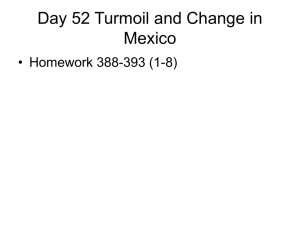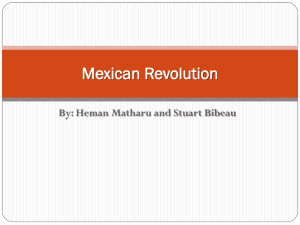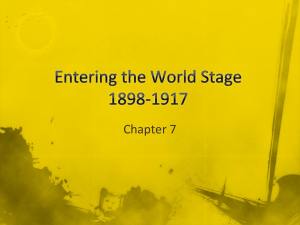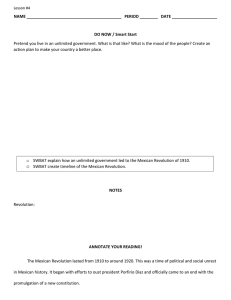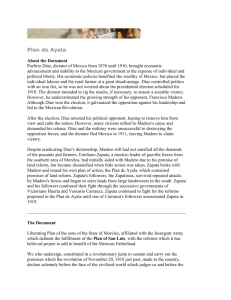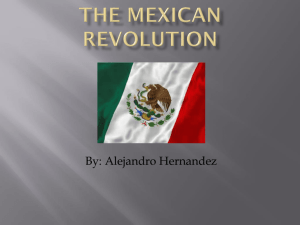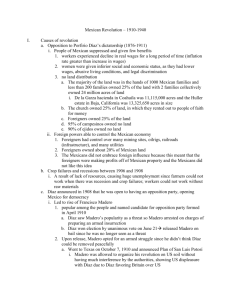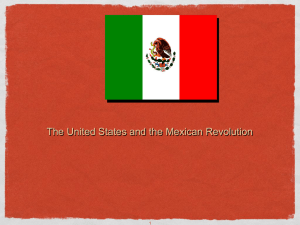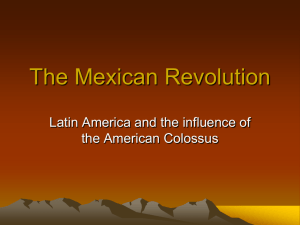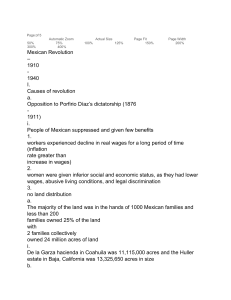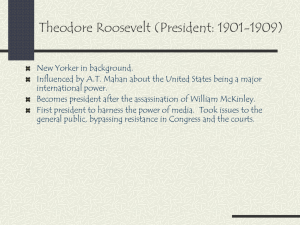File
advertisement
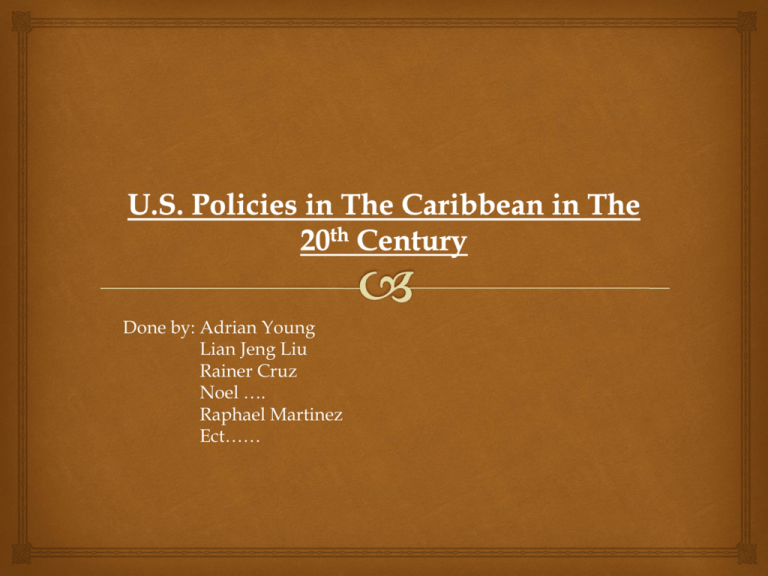
Done by: Adrian Young Lian Jeng Liu Rainer Cruz Noel …. Raphael Martinez Ect…… In the twentieth century, U.S. foreign policy toward the Caribbean Basin can be divided into four periods: 1. (1) the protectorate era, 1898-1933; 2. (2) the Good Neighbor Policy, 1933-1953; 3. (3) the Cold War, 1953-1990, (when security concerns about communism shaped U.S. policy) 4. (4) the post-Cold War era ( when the importance of the Caribbean to U.S. strategic interests has diminished, and U.S. policy is driven by a new set of concerns. ) In the early 19th century, in the Caribbean basin, public and especially Congressional support for American foreign policy, was mobilized by exaggerating the danger to U.S. national security. President Wilson approved the establishment of a military government in Veracruz in 1914, and in the Dominican Republic in 1916, and a military protectorate in Haiti. President Wilson In 1927 Under Secretary of State, Robert Olds noted: ". . . We do control the destinies of Central America (including the Caribbean Basin) and we do so for the reason that the national interest absolutely dictates such a course. There is no room for any outside influence other than ours in this region. We could not tolerate such a thing without incurring grave risks. . . . Central America has always understood that governments which we recognize and support stay in power while those we do not recognize and support fall." Instances of U.S. Meddling By the start of the century, the United States continued its interventionist attitude, which aimed to directly defend its interests in the region. This was officially articulated in Theodore Roosevelt's Big Stick Doctrine, which modified the old Monroe Doctrine, which had simply aimed to deter European intervention in the hemisphere. At the conclusion of the Spanish-American War the new government of Cuba and the United States signed the Platt Amendment in 1902 This authorized the United States to intervene in Cuban affairs when the United States deemed necessary. In Colombia, United States sought the concession of a territory in Panama to build a much anticipated canal across the isthmus. The Colombian government opposed this, but a Panamanian insurrection provided the United States with an opportunity. The United States backed Panamanian independence and the new nation granted the concession. These were not the only interventions carried out in the region by the United States. In the first decades of the twentieth century, there were several military incursions into Central America and the Caribbean, mostly in defense of commercial interests, which became known as the "Banana Wars." Mexican Upheaval The greatest political upheaval in the second decade of the century took place in Mexico. In 1908, President Porfirio Díaz, who had been in office since 1884, promised that he would step down in 1910. Francisco I. Madero, a moderate liberal whose aim was to modernize the country while preventing a socialist revolution, launched an election campaign in 1910. Porfrio Díaz Díaz, however, changed his mind and ran for office once more. Madero was arrested on election day and Díaz declared the winner. These events provoked uprisings, which became the start of the Mexican Revolution. Revolutionary movements were organized and some key leaders appeared: Pancho Villa in the north, Emiliano Zapata in the south, Madero in Mexico City. Francisco I. Madero Madero's forces defeated the federal army in early 1911 They assumed temporary control of the government and won a second election later on November 6, 1911. Madero undertook moderate reforms to implement greater democracy in the political system but failed to satisfy many of the regional leaders in what had become a revolutionary situation. Madero's failure to address agrarian claims led Zapata to break with Madero and resume the revolution. Emiliano Zapata On February 18, 1913 Victoriano Huerta, a conservative general organized a coup d'état with the support of the United States. Madero was killed four days later. Other revolutionary leaders such as Villa, Zapata, and Venustiano Carranza continued to militarily oppose the federal government, now under Huerta's control. Pancho Villa Victoriano Huerta Venustiano Carranza Allies Zapata and Villa took Mexico City in March 1914, but found themselves outside of their elements in the capital and withdrew to their respective bastions. This allowed Carranza to assume control of the central government. He then organized the repression of the rebel armies of Villa and Zapata, led in particular by General Álvaro Obregón. The Mexican Constitution of 1917, still the current constitution, was proclaimed however initially it was very weakly enforced. The efforts against the other revolutionary leaders continued. Zapata was assassinated on April 10, 1919. Carranza himself was assassinated on May 15, 1920, leaving Obregón in power, who was officially elected president later that year. General Álvaro Obregón Finally in 1923 Villa was also assassinated. With the removal of the main rivals Obregón is able to consolidate power and relative peace returned to Mexico. Under the Constitution, a liberal government is implemented, but some of the aspirations of the working and rural classes remained unfulfilled. Time Line of Events 19th Century CENTURY DATE EVENT 1823 The Monroe Doctrine declares Latin America to be in the United States "sphere of influence." 1846 The U.S. provokes war with Mexico and acquires half of its territory, including Texas and California. 1855 U.S. adventurer William Walker invades Nicaragua with a private army, declares himself president, and rules for 2 years. 1898 The U.S. declares war on Spain and as a result annexes Guam, Puerto Rico, the Philippines and Hawaii. 20th Century CENTURY DATE EVENT 1901 With the Platt Amendment, the U.S. declares its unilateral right to intervene in Cuban affairs. 1903 The U.S. encourages Panama's independence from Colombia in order to acquire the Panama Canal rights. The Roosevelt Corollary to the Monroe Doctrine declares the U.S. to be the 1905 policeman of the Caribbean; the Dominican Republic is placed under a customs receivership. 1912 U.S. Marines invade Nicaragua and occupy the country almost continuously until 1933. 1914 Mexican refusal to salute the U.S. flag provokes the shelling of Veracruz by a U.S. battleship and the seizure of parts of the city by U.S. Marines. 1933 U.S. Marines finally leave Nicaragua, but are replaced by a well-trained and wellarmed National Guard under the control of Anastasio Somoza. 1954 The CIA engineers the overthrow of the democratically-elected government of Guatemala; 30 years of military dictatorship, repression, and violence follow. CENTURY DATE 1961 EVENT The U.S. attempts to overthrow the revolutionary Cuban government at the Bay of Pigs. U.S. begins a trade embargo: It becomes illegal for U.S. citizens to conduct business with Cuba or travel there. 20th Century One of the most serious incidents of the Cold War, the Cuban missile crisis, occurs in October when the U.S. learns that the Soviet Union has secretly installed missiles in 1962 Cuba. The Soviet Union agrees to U.S. demands that it removes its missiles and dismantles the remaining missile bases. 1965 US President Johnson sends 22,000 troops to the Dominican Republic to combat the constitutional forces trying to regain power. 1973 The CIA helps overthrow the democratic government of Allende in Chile in favor of a bloody dictatorship. 1981 The Reagan Administration begins the contra war against Nicaraguan civilians. 1983 The U.S. invades Grenada to overthrow a popular government. 1989 The U.S. invades Panama to arrest accused drug dealer Manual Noriega. 1990 The U.S. intervenes in the Nicaraguan election process through covert and overt means. That Concludes our presentation. :] ThankYou
